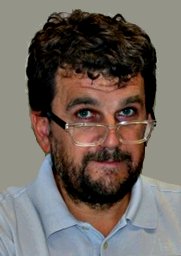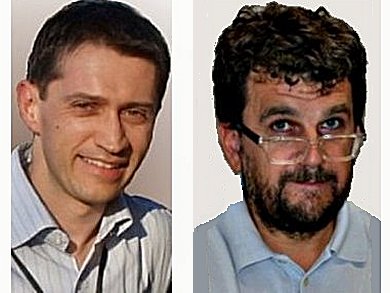Professor Gianluca Giorgi, University of Siena, Italy, and Dr. Vera Koester, ChemViews magazine, spoke to Dr. Michele Suman from Barilla, and Dr. Franco Biasioli from the Istituto Agrario di S. Michele all’Adige-Italy (now Fondazione Edmund Mach), all Italy, about analytical chemistry in the food industry and recent trends.
Food quality, food safety, and food traceability: How important are these aspects in the modern food industry and research centers?
Michele Suman: The modern food industry has to face challenges such as globalization of the market, exasperation of “just in time” approaches, increased demand for premium foods from emerging economies, in a contemporaneous context.
Industrialized countries are passing a serious period of economic crisis with rising prices and scarcity of raw ingredients that pushes fraud and adulteration. Therefore, the continuous development of strategies for improving and guaranteeing the safety, quality, and integrity of food is a connecting point between the needs of the food industry and the objectives of research centres.
Franco Biasioli: The hard competition in the food global market may lead unscrupulous companies to look for cheaper but illegal raw materials. For this reason traceability has increasing economic relevance. Food traceability is a battle field where the arsenal of the analytical chemist, mass spectrometry in particular, is widely used.
And food quality! It is impossible to address all possible aspects hidden behind this word ranging from sensory and perceived quality to the nutritional and hedonistic aspects.
So what has the highest priority in your opinion? Food quality, food safety, or food traceability.
Franco Biasioli: I’m a little bit biased, maybe because I’m Italian or because I spend most of my time working with flavor compounds. So, even if food safety is a must and comes before anything else, and even if food traceability is getting more and more important, I would like to give more attention to food quality and in particular to its perceived quality. It is a kind of added value that makes food not only the fuel for our body but also helps in enjoying life and preserving our history and culture.
Michele Suman: In my opinion, the priority has to be set on food safety. The right direction is to pursue continuous synergy between basic research, developed by Universities and public-private partnerships, and applied research carried out by R&D industry teams that need to assess analytical priorities and direct these innovations in the areas of effective implementation in the field, in the real world.
And what would you say is more important, flavor or taste?
Michele Suman: The answer is for sure flavor! Taste can be conceived as one of the five traditional senses, as a sensation produced when a substance reacts in the mouth chemically with receptors of taste buds.
But flavor is a more complex sensory impression that combines the taste with the smell through trigeminal senses and represents a more complete outcome of the consumer’s perception and preferences with respect to a specific food product.
In the last decades, many different studies were aimed to investigate the mechanism and the characteristics of taste origins at the tongue level. Unlike taste, smell cannot be easily classified into various groups. Humans can distinguish around 10,000 chemicals, with olfactory receptors being stimulated by different combinations of a limited number of primary odors. A further distinction can be made when talking about “aromatics” as volatiles perceived from a substance in the mouth and “odors” as volatiles sniffed through the nose.
The food industry has a direct interest in tasting/smelling substances either for the identification of negative off-flavors or for the monitoring of a desired organoleptic quality. The recent progress devoted to build more robust and flexible artificial e-nose/e-tongue platforms can be very interesting to boost synergies between sensory and analytical sciences.
Are flavor and taste equally important for you, Mr. Biasioli?
Franco Biasioli: There is a famous experiment that demonstrates that even color can be more important than flavor: people were enjoying their food in a dark environment. When the light was switched on, they recognized that the food was strangely colored: green/blue meat and red vegetables. As a result, they were not able to keep eating. It is like listening to a symphony: you would say that violins are more important than the contrabass or bassoon, which are hardly noticed. Just try to cut the sound of these latter instruments and the music will completely change and lose all its strength. So, I think I must say that both odor and taste are important, as well as color, texture, environment, sound, habits, …
Maybe I should mention that, technically, flavor includes also taste, but I think it is clear what we are talking about.
Which methods do you use for studying food in your laboratory?
Michele Suman: At Barilla, there is a strong application of low/high resolution MS combined either with gas or ultra-high performance LC, working progressively towards the development of multianalytical methods that permit us to quantitate easily and precisely different classes of molecules, both from the safety or the quality point of view.
Rheological properties also need to be evaluated through exploitation of dedicated instruments, such as alveographs, dynamometers, and rheometers.
Then there is a stable base of microscopy and spectroscopy applications moving from UV to IR with a high interest for the relevant potentialities expressed by FT-NIR (fourier transform nearinfrared spectroscopy) instruments for the quick evaluation of many parameters thanks to a predefined correlation with data from traditional analytical methods.
Besides, we exploit also rapid tools based, for example, on X-ray fluorescence (XRF), on cytometry, on immunoassay formats such as ELISA kits, Lateral Flow Devices, Fluorescence Polarization, …
Franco Biasioli: We try to use a comprehensive approach that compares and correlates different ways to characterize food: from sensory analysis where test people are used as instruments to evaluate the perceived quality of food, to basic food characterization, from cognitive psychology and consumer science to advanced instrumentation to detect and quantify volatile compounds, mostly gas-chromatography and mass spectrometry. Other tools allow us to measure texture properties of food along with its acoustic properties or to classify food samples according to shapes and colors, the so called electronic eye.
Statistics and data mining are obviously necessary to manage and investigate the large and diverse datasets produced. Nowadays, a single methodology is not enough; we must learn to handle the complexity of food and its interaction with us.
In which areas is mass spectrometry used?
Franco Biasioli: What is amazing about mass spectrometry is that it is no more an esoteric and mysterious method needing huge apparatuses and teams of skilled scientists, as it was some 30 years ago. It is now becoming more and more accessible and applied in almost any research and technology sector and, obviously, also in food science and technology.
In my laboratory, for instance, we use an innovative approach based on the direct injection of volatile compounds in a mass spectrometer without using, as taught by the holy books of analytical chemistry, a preliminary gas chromatographic separation. The technique is called Proton Transfer Reaction Mass Spectrometry (PTR-MS) and allows the monitoring of volatile compounds in real-time with very high sensitivity.
An intriguing paradigmatic application is the real-time monitoring of the concentration of volatile compounds “in” the nose during food consumption: the so called nose-space analysis. It means that we are able to quantify the genuine mixture that interacts with our olfactory receptors.
It can also be used for the rapid and non-invasive characterization of food samples possibly in correlation with other, more expensive and time consuming methods, such as sensory analysis or genomics.
Other mass-spectrometry-based analyses carried out by colleagues in my institute range from the quantification of pesticides and other residues to the complete investigation of the metabolome of vines and apples, from the traceability of food to the investigation of plant physiology. Recently, my laboratory was also active in the monitoring of air quality and in the measuring of the volatile compounds in the breath of people and animals with relation to diet and diet-related diseases. There is a lot to play around with.
Mr. Biasioli, which trends do you see in food analysis?
Franco Biasioli: Difficult question; difficult to summarize in a few lines.
From my particular point of view I see different key trends. One is the continuous development of new instruments that are faster and faster and provide more and more sensitivity and specificity. Unfortunately they are also often more and more expensive with longer and longer names and acronyms. Someone told me that acronym length and prices are proportional. Anyway, we must bring these developing technologies into practical contexts and offer to a wider audience the possibility to have accurate and informative food characterization.
At the same time, we must learn to cope with the huge amount of data that is usually produced by the advanced methods, such as mass spectrometry. It is incredible how software and proper data analysis are often the bottleneck in many applications.
A second trend is the understanding of the relevance for the human being of the chemical information we get from our sophisticated instruments. It means, the correlation of analytical information with human health or with the perceived quality of food. In the end it means having the necessary information to produce healthier and better food.
A way to address these issues is the “omic” fashion: the idea of providing a complete description of all molecules that play a role in a given system. Foodomics is, in particular, the attempt to apply the omics philosophy to food and nutrition. We are still at the beginning of the history but I’m sure that we will soon see important results and applications.
Which trends do you see, Mr. Suman?
Michele Suman: Mass spectrometry is constantly used in food safety and quality analysis, from mycotoxins to vitamins, from plasticizers to food emulsifiers, and so on. It is also a strategic technique for evaluating markers correlated to food aroma profiles, to geographic origin, etc. High resolution mass spectrometry is, in my opinion, for sure the most promising technique, and it is destined to be progressively exploited.
On the other hand, high-throughput, reliable, rapid screening technologies, such as FT-NIR or biosensors, represent the other relevant future necessity for the food-industry sector. In fact, the confirmatory analytical techniques available nowadays are very powerful and effective, but often they are expensive and time consuming, so there is the simultaneous need to improve the potential of high throughput and cheaper screening systems for executing wide monitoring in real time. The most advanced instruments—such as the High Resolution Mass Spectrometry (HRMS) I spoke about earlier—will become more and more indispensable for the flexibility, which allows us to obtain either the precise quantification of tenths or hundreds of contaminants and active principles in a single analytical run, or the opportunity to investigate the presence of other substances unwanted or unplanned. Techniques of so-called post-acquisition processing or non-targeted analysis are possible thanks to the development of contemporary chemometric science.
One of the main targets for the future food industry is to increase the affordability, the convenience and the distribution of food around the globe by keeping it as stable as possible for a long time.
All these aspects mean increased importance of exact storage, processing, and packaging solutions.
In this sense, I see a brilliant future for research on mild pasteurization/sterilization technologies, active and multilayer-barrier packaging systems, intelligent labeling, remote devices for storage monitoring, and so on.
Generally speaking, the food of the future is destined to be more and more complicated in terms of combination of tastes, ingredients, functional molecules, …
In your experience, which is the most difficult food to be studied by MS?
Michele Suman: On the meal solutions side, I would say that a difficult matrix is represented by fatty sauces, such as pesto Genovese, on the bakery side a filled minicake can show a high complexity due to the number and type of ingredients, the structure, e.g., sponge, cream, etc., or the baking treatment effects.
Franco Biasioli: We are at the moment fighting with wine and alcoholic beverages. They are in general a difficult and complex matrix with hundreds of compounds that change in time also over relation with storage conditions. Moreover, compounds present in traces can play a crucial role and, although it can be difficult to detect them by analytical methods, they can easily be recognized by our nose. In the case of the direct and on-line methods I mentioned before, which do not perform a preliminary gas-chromatographic separation, a further difficulty comes from the high ethanol concentration that suppresses the main precursor ion and produces many interfering species. It is, however, an important challenge and we have a couple of ideas on the way to solve these problems. I hope that we will soon publish interesting results. It seems that too much alcohol is not good—also for a mass spectrometer …
Has your profession effects on your diet?
Franco Biasioli: Yes. Unfortunately, it has. It happens quite often that interesting samples, wine and ham, for instance, are available at the end of the experiments and, you know, someone must take care of them.
Michele Suman: Yes, of course! In Barilla, in particular, one of the important parameters used by Human Resources on the selection of new employees is a passion for food!
By the way, it is unavoidable that my work on food safety and quality issues has a direct impact in my food consumption habits, but at the same time I want to highlight the fact that food remains not only a primary human need to survive; it is one of the main pleasant things about the life!
I think that the right behavior still remains to get a variety of foods every day, not necessarily to always avoid some of them. Therefore, even if I am aware, for example, of mercury or acrylamide risks sometimes, in any case, I really enjoy a good meal based on fish and chips!
Thank you very much for the interview.

Franco Biasioli studied at the University of Trento, Italy, and gained his Ph.D. from the University of Innsbruck, Austria, specializing in the multivariate analysis of spectrometric data.
Since 2000, he has been a researcher at the Istituto Agrario di S. Michele all’Adige-Italy (now Fondazione Edmund Mach), Italy, where he set up a facility for the rapid and high sensitivity detection of volatile compounds.
Biasioli currently investigates the application of direct injection mass spectrometry for Volatile Organic Compounds (VOC) detection in food science and technology, agronomy and related topics: rapid product characterization, on-line process monitoring, correlation of food VOCs profile with sensory analysis and genomics, breath analysis and nose-space measurements. His activity further comprises statistical-analysis and data-mining methods applied to spectrometric and sensory data.
He co-authored more than 100 papers in ISI journals, more than 200 contributions to national or international conferences, 21 technical papers, two book chapters, and holds a patent.
Selected Publications of F. Biasioli
- Rapid “breath-print” of liver cirrhosis by proton transfer reaction time of flight mass spectrometry. A pilot study,
F. Morisco, E. Aprea, V. Lembo, V. Fogliano, P. Vitaglione, G. Mazzone, L. Cappellin, F. Gasperi, S. Masone, G. De Palma, N. Caporaso, F. Biasioli,
PLOS ONE 2013, 8, e59658.
DOI: 10.1371/journal.pone.0059658 - Monitoring the Effect of High Pressure and Transglutaminase Treatment of Milk on the Evolution of Flavour Compounds during Lactic Acid Fermentation using PTR-ToF-MS,
M. Tsevdou, C. Soukoulis, L. Cappellin, L. Gasperi, P. S. Taoukis, F. Biasioli
Food Chem. 2013, 138, 2159–2167.
DOI: 10.1016/j.foodchem.2012.12.007 - PTR-ToF-MS and data mining methods: a new tool for fruit metabolomics,
L. Cappellin, C. Soukoulis, E. Aprea, P. Granitto, N. Dallabetta, F. Costa, R. Viola, T. D. Märk, F. Gasperi, F. Biasioli,
Metabolomics 2012, 8, 761–770.
DOI: 10.1007/s11306-012-0405-9

Michele Suman studied at the University of Ferrara, Italy, and gained his PhD in Science and Technology of Innovative Materials from the University of Parma, Italy, in 2005. During his studies he also worked at the “Natta Research Center” of Shell-Montell Polyolefins, Italy. In 2003 he started working for Barilla SpA, Parma, Italy, as Food Chemistry & Safety Research Manager.
Suman is a member of working groups of the European Committee for Standardization (CEN) and of the ILSI Process Related Compounds & Natural Toxins Task Force. He is a member of the Board of the Mass Spectrometry Division of the Italian Chemical Society (SCI) and of the the Italian section of the European Technology Platform “Food For Life”, and WP Leader of the EU-FP7 Food Integrity Project.
He is author of two book chapters, 40 papers in international ISI journals, and of 70 contributions at national and international conferences.
Selected Publications of M. Suman
- Fluorescence Polarization Immunoassay for Rapid, Accurate and Sensitive Determination of Ochratoxin A in Wheat,
V. Lippolis, M. Pascale, S. Valenzano, A. C. R. Porricelli, M. Suman, A. Visconti,
Food Analytic. Meth. 2014, 7(2), 298–307.
DOI: 10.1007/s12161-013-9627-3 - Liquid chromatography–full scan-high resolution mass spectrometry-based method towards the comprehensive analysis of migration of primary aromatic amines from food packaging,
M. Mattarozzi, F. Lambertini, M. Suman, M. Careri,
J. Chromatogr. A 2013, 1320, 96–102.
DOI: 10.1016/j.chroma.2013.10.063 - Mitigation strategies of furan and 5-hydroxymethylfurfural in food,
M. Anese, M. Suman,
Food Res. Int. 2013, 51, 257–264.
DOI: 10.1016/j.foodres.2012.12.024




